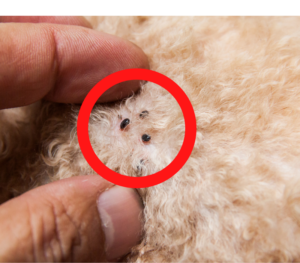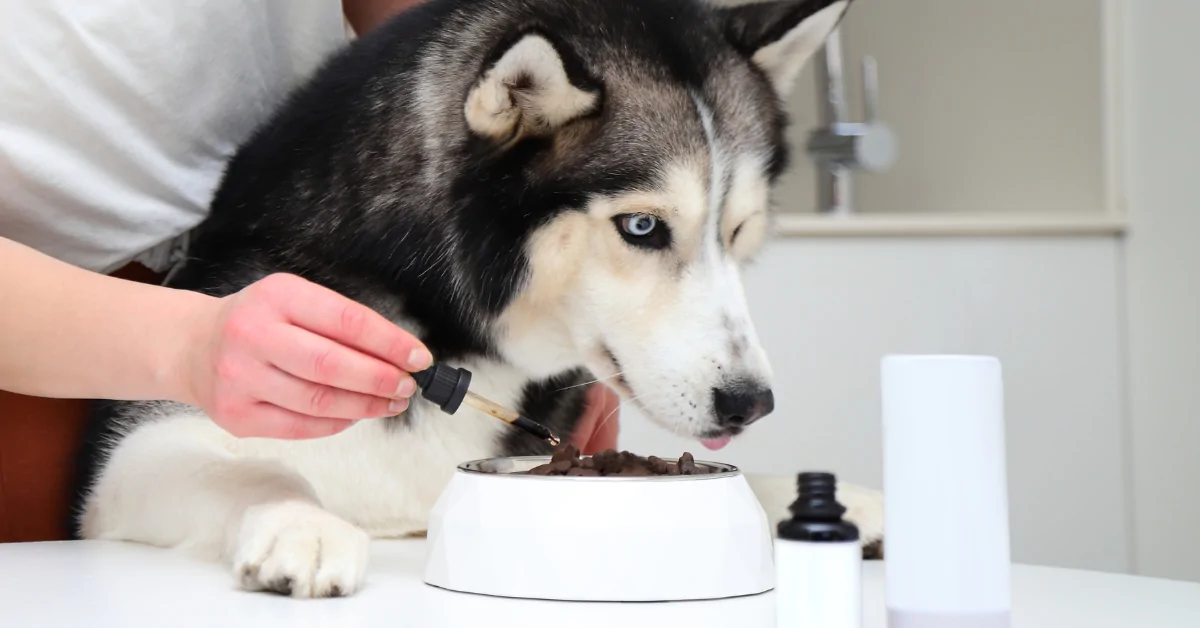
Dog biting at bug bite.
Sting. OUCH! That hurts, right?
Who likes getting stung by a bug? Nobody. But, at least as a human, you can squash the bugs that bother you quite easily. But what about your furry friend over there? How are they supposed to deal with bug bites?
Wait a second….can dogs even get bug bites? Or does all that fur serve more of a purpose than just being fun to run our hands through? And what are you supposed to do if they do get stung or bitten by a bug?
We’ll answer all that and more in this short read below!
Can Dogs Get Bug Bites?
Yes! Of course dogs can get bug bites. Dogs are not so different from humans that they’re able to evade being bitten or stung by bugs. It’s just a fact of being out and about in nature – -sometimes it hurts you!
Can Dogs Get Mosquito Bites?
Yes again: mosquitoes can bite dogs. We’re just glad that we live in a day and age where there are now pet-safe mosquito repellents and mosquito sprays for dogs.
What Causes Reactions to Bug Bites and Stings?
Mostly when a bug bites or stings you or your dog, they’ll release a small amount of venom or formic acid into your body. Once either of those enters you or your dog’s body, the immune system will respond to it and begin trying to heal the site.
As a result, the body will have an immediate reaction which causes redness and swelling at the site. You may also develop slight itchiness or soreness at the site of the bite or sting, depending on what stung you. For most pets and people, this is the extent of the discomfort caused by bug bites or stings.
However, not all dog bug bites or stings produce such mild reactions. Some people and pets can be very sensitive to the chemical compounds found within venom or formic acid. For these individuals, there is a risk of going into anaphylactic shock. Individuals who go into shock from bug bites or stings may have their throat tighten, experience low blood pressure, or even die.
That’s why it’s important to be able to identify the different signs and symptoms of the various kinds of insect bites that your dog may experience – knowing what to look for can literally save her life!
What are the Symptoms of Bug Bites in Dogs?
The type of symptoms that your dog will display after being bitten or stung by a bug depends on what type of insect bit or stung them. Five of the most common types of insect bites and stings in dogs are discussed in more detail below
Fleas

Dog with Fleas
Fleas are bloodthirsty insects that latch onto the surface of our pets’ skins, most commonly around the head, neck, groin, and tail base. Because fleas are very allergenic, a single flea bite can cause your dog to itch all over her body.
Symptoms of flea bites in dogs include:
- Excessive licking of the site
- Chewing around the affected area
- Persistent scratching of the affected area
- Swelling around the bites
- Redness of the skin
- Hair loss around the bitten area
- Crusting and oozing on the site of the bites
Ticks

Tick attached to Dog Skin
Ticks, like fleas, are bloodthirsty insects that will latch themselves to dogs and slowly traverse their skin until they can find a suitable place to bite. They can live anywhere and be found during every season and are most commonly found in tall grass or bushes during warm weather.
It’s very easy for dogs to pick them up just by brushing against blades of grass or other environmental surfaces. Ticks are most commonly discovered on the face, head, ears, and flanks of dogs and cats. They are also very dangerous bugs that can transmit serious diseases to dogs including Lyme disease, Rocky Mountain spotted fever, and ehrlichiosis.
Symptoms of tick bites in dogs include:
- Swelling around the bites
- Redness around the area of the tick bite
- Crusting or oozing around the bite (once the tick has been removed)
Mites

Dog with Ear Mites
Unlike ticks or fleas, mites are incredibly hard to detect because they are microscopic in size and tend to burrow deep into dogs’ skin. However, they have to bite through your pet’s skin in order to burrow, so they leave lots of inflammation in their wake. Mites most commonly leave lesions around the armpits, groin, ears, and other areas with minimal hair. Moreover, their chewing path may leave your dog vulnerable to developing secondary skin infections.
Symptoms of mites in dogs include:
- Inflammation around the affected area
- Excessive itching around the affected area
- Swelling around the bites
- Redness of the skin
- Hair loss around the bitten area
- Crusting and oozing on the site of the bites
Mosquitoes

Mosquito Bites on Dogs
Just like humans, dogs can suffer from mosquito bites. However, unlike humans, dogs are much more likely to feel the sensation of a mosquito biting them. As a result, it’s very common for dogs who are being bitten by mosquitoes to immediately start licking, chewing, or scratching at the bite site. All body surfaces on dogs are prone to being targeted by mosquitoes.
Unfortunately, mosquitoes carry a larger potential risk to dogs than just itching: some mosquitoes may carry heartworm larvae. If a mosquito who carries a heartworm larva bites your dog, they may transmit the heartworm disease to her.
Symptoms of mosquito bites in dogs include:
- Itching at the affected area which may last for minutes to hours
- Swelling around the bites
- Redness of the skin
- Hives around the bitten area
Bees, Hornets, and Wasps

Bee stings are more likely to happen when provoked.
Bees, hornets, and wasps are flying insects that display varying levels of aggression towards other animals. Bees often will not sting a dog unless they’re provoked or fearful. However, because dogs love to learn with their mouth and snap at bees, plenty of dogs get stung every year. Wasps and hornets, on the other hand, are much more territorial and aggressive and may sting your dog preemptively.
Whichever member of this trifecta ends up stinging your dog, you can be sure they’ll be responsible for a significant amount of discomfort or pain. Normally that’s where the risk of being stung by a bee, wasp, or hornet ends. However, things can get much dicier if your dog is allergic to the venom of a bee, wasp, or hornet sting. In the event of an allergic reaction, your dog may go into anaphylactic shock which can be fatal.
Symptoms of bee, wasp, and hornet stings in dogs can include:
- Swelling around the bites
- Redness of the skin
- Hives around the bitten area
- Vomiting
- Diarrhea
- Stumbling
- Collapse
- Low-blood pressure
How to Treat Bug Bites in Dogs
Much like the great variation in the symptoms that different insects’ bites or stings cause, there is also substantial variation in how to treat different bugs’ bites.
How to Treat Flea Bites in Dogs

Bathe Dog for Fleas with Medicated Shampoo
The most effective treatment for fleas in dogs is to give them preventative flea medications. These flea medications, which can be oral or topical, contain active ingredients that are spread to fleas and kill them when they bite your dog.
However, if you can’t prevent your dog from picking up fleas, bathe him in a medicated flea-killing soap or shampoo. Additionally, you will definitely need to vacuum or wash the areas that your dog hangs out in to minimize the chance of a recurrent problem. Flea eggs can hang around for many months.
How to Treat Tick Bites in Dogs
Luckily, many of the same medications that you can give to dogs to prevent fleas will also help keep ticks away! Additionally, you’ll want to make sure to check your dog thoroughly after every walk or every time they romp around in the grass. This will make sure you catch ticks before they have time to do their damage.
If you do catch a tick, remove it from your dog’s body with tweezers. Do this by grasping the tick tightly and pulling gently until it unlatches itself from your dog’s skin. Emphasis on gentle – those babies can pop and then you have a real mess on your hands—literally!
How to Treat Mites in Dogs

Vets recommend keeping up with your dog’s doses of heartworm medication during the warmer months.
According to The Animal Clinic of Woodruff, the most effective way to treat a mite infestation in your dog is to cut their hair short and give them a medicated bath once a week for a month. Additionally, the clinic advises pet owners to treat their dog’s bedding and other areas where their dog hangs out with insecticide to truly rid their household of the mites.
How to Treat Mosquito Bites in Dogs
When trying to treat mosquito bites in dogs, there’s not a lot to do, per se. Yes, there are dog-friendly mosquito repellants you can use. But, the real thing you should be trying to do is minimize the chance of your dog contracting heartworm from mosquitoes.
According to the University of Illinois College of Veterinary Medicine, it is very important to keep up with your dog’s doses of heartworm medication during the warmer months when mosquitoes are most active.
How to Treat Bee, Wasp, and Hornet Stings in Dogs

Dog Allergic Reaction to Bee Sting
Similarly, with mosquitoes, there are not a lot of ways to prevent your dog from encountering bees, wasps, or hornets. Especially not during the summer when they’re most active. Instead, try to keep your dog away from areas where these flying insects are most commonly found like flowers or small food gardens.
If your dog does get stung by one of these insects, don’t fret. Just treat it the way you would treat your own bee, wasp, or hornet sting. In the case of a bee sting, try to look for and remove the stinger to minimize the amount of venom that can be injected into the dog’s body. Afterward, apply an ice pack to the affected area to reduce swelling. You may also want to make a thick paste of baking soda and water and apply it to the stung area to soothe any discomfort.
If your dog is stung by a bee, wasp, or hornet and displays the signs of an allergic reaction, get them to a veterinarian immediately. The veterinarian will give them antihistamines to reduce the swelling. They may also administer epinephrine as a cautionary measure. Additionally, your vet may administer both IV fluids and oxygen to stabilize your dog and encourage respiration.
Treating a dog for bug bites, of course, may all just be common sense to you. After all, we know you’re a good pet parent who’s always trying to find new, better ways to care for your four-legged friends – otherwise, you wouldn’t be reading our blog !
But nobody knows everything about their dog, right? Like…do you know how to treat a dog’s runny nose? Wipe it? Wrong. Or are you? Only one way to find out…or do you know how long your dog can go without peeing?
Share this Post
Featured Post
Recent Posts

Managing the Mamas –Part 2 –The development process

Managing the Mamas: Part 1 – Preparing to Breed Your Mare

HOW MANY TOES?? Caring for the Polydactyl Cat

Do Dog Joint Supplements Actually Work?

Are Laser Pointers Bad for Cats? or, are they Purr-e Fun?



